As the Ottawa Senators rebuild is in full swing, most fans turn to look at the future of the organization. Teams’ prospects are scrutinized as much, if not more than the players already in the NHL lineups. Introducing a prospect pyramid can further categorize a team’s prospects, placing them into tiers to evaluate what to expect from them in the future and how they might progress moving forward in their careers.
The Senators are at a point where the prospects are the most important part of the organization. They will directly impact whether or not the future Senators will be successful or not.
What is a Prospect Pyramid?
Sportsnet correspondent Steve Dangle first created the idea of a prospect pyramid for the Toronto Maple Leafs and has since become the new standard of sorting prospects in an organization. Dangle says that rather than trying to sort prospects in a numbered list, ranking them into tiers makes more sense than trying to decide who’s 15th and who’s 16th. The tiers look at their potential and group them accordingly rather than ranking them subjectively.
To explain the six tiers, here’s a written out breakdown, courtesy of THW’s own Brandon Share-Cohen:
Tier 1 – Elite talent (Rasmus Dahlin, Auston Matthews, Connor McDavid-level talent)
Tier 2 – Very, very good prospects with a real chance of being top-six forwards, top-two defenders or good starting goalies
Tier 3 – Good players who fall just short of tier 2, perhaps due to lower ceilings, but who are distinctly better than tier’s below them
Tier 4 – Distinct shot at making an NHL roster and being a contributor (top-nine forward, bottom-four defender, fringe starter or backup goaltenders
Tier 5 – Players who likely don’t project to be anything more than a role player in the NHL as their ceiling – these players chances of making the NHL aren’t very high compared to their comrades (sometimes due to being relatively unknown at this point)
Tier 6 – Players who have an uphill battle to make the NHL, or there isn’t enough information to make an informed decision
Also, there’s always talk about who classifies as a prospect. The Athletic’s Corey Pronman uses a good definition in his work, which I will apply here:
“A skater no longer qualifies as an NHL prospect if he has played 25 games in the NHL in any campaign, regular season and playoffs combined, or 50 games total; or reaches age 27 by Sept. 15.
“A goalie no longer qualifies as an NHL prospect if he has played 10 games in the NHL in any campaign, regular season and playoffs combined, or 25 games total; or reaches age 27 by Sept. 15.” (From: “Pronman: 2019-20 NHL Farm System Rankings”).
Additions, Subtractions and Graduates
As the organization looks to build for the future, there’s lots of movement in the team’s system. Since the last edition of this pyramid in Feb. 2019, there have been many changes. Without going into too much detail, here’s how the list has changed.
Additions
Trades: Vitali Abramov, Erik Brannstrom, Michael Carcone, and Jonathan Davidsson
Free Agents: Olle Alsing, Nick Ebert, and Max Veronneau
Draft: Lassi Thomson, Shane Pinto, Mads Søgaard, Victor Lodin, Mark Kastelic, and Maxence Guenette
Subtractions
Trades: Julius Bergman, Aaron Luchuk, and Patrick Sieloff
Free Agency: Filip Ahl, Jordan Hollett, and Adam Tambellini
Graduates
Played more than 25 games: Rudolfs Balcers and Christian Wolanin
Played more than 50 games, overall: Nick Paul
Tier 1: Empty
Tier one is extremely hard to crack. In fact, most teams don’t have a tier-one prospect. Usually, these players make the jump straight to the NHL, just like Dahlin, Matthews and McDavid all did. Looking at the younger players on the Senators, Thomas Chabot and Brady Tkachuk would have come closest to this tier when they were prospects. Chabot would have a better shot here as he was a star in the QMJHL, succeeded with Team Canada at the World Junior Championships and didn’t waste much time in the AHL.
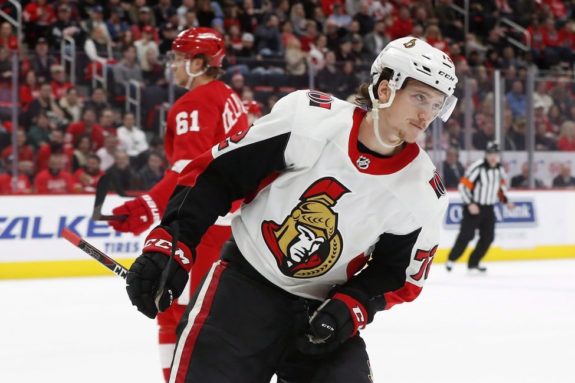
Even still, he would likely be a tier-two prospect, as it wasn’t a certainty for him to make the jump straight to the NHL. Similarly, Tkachuk has already proven that he’s a top-six forward, but he does have room to improve. This was known when he was drafted, and when he was coming in there were questions on whether or not he’d make the team, which would knock him down to tier two.
As mentioned, most teams don’t have players in this category as they are very hard to come by and don’t remain prospects for long. These players usually only come from high draft picks, so there’s potential in the very deep 2020 NHL Draft, where the Senators are expected to have a high pick.
Tier 2: Batherson, Bernard-Docker, Brannstrom, Brown, Formenton, Gustavsson, Norris, Søgaard & Thomson
While tier one may be disappointing to some Senators fans, tier two has a lot to be excited about. The Senators have a number of players here who could even make the roster this season and should become top-six forwards, top-four defensemen or a first-string goaltender. Those players are Drake Batherson, Jacob Bernard-Docker, Erik Brannstrom, Logan Brown, Alex Formenton, Filip Gustavsson, Josh Norris, Mads Søgaard and Lassi Thomson.
With the way Batherson looked for the AHL’s Belleville Senators in 2018-19, he could almost be at the cusp of tier one. He’s not quite there, but there is a ton of promise in the young winger. Batherson is currently the top forward prospect in Senators system, which is a huge accomplishment considering he was drafted in the fourth round of the 2017 NHL Entry Draft. He has been at or above a point-per-game in the QMJHL, with Team Canada (where he won a gold medal) and in his rookie season with Belleville, earning him an All-Star nod, All-Star MVP, and was named to the AHL All-Rookie Team.
Brannstrom looks to be the new top prospect in the organization. Acquired in the trade that sent Mark Stone to the Vegas Golden Knights, the Swedish defender is one of the best prospects in the entire NHL. Originally drafted 15th overall in 2017 by the Golden Knights, the defender showed that he can bring his SHL talent to the North American game. He put up 32 points in 50 AHL games between the Chicago Wolves and Belleville while playing his first two NHL games. He’s highly decorated already, with an SHL championship, two World Junior Championship silver medals (U20 and U18) and too many individual awards and accolades to list here.
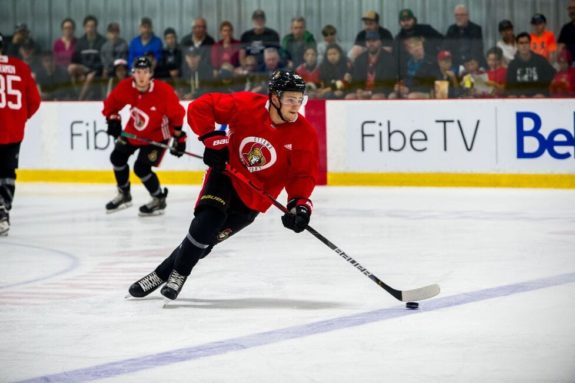
The rest of tier two is right behind Batherson and Brannstrom. Brown had a huge bounce-back season after missing a month to an injury to start 2018-19. The 11th-overall pick in 2016 has two World Junior Championship bronze medals, a Memorial Cup and was over a point-per-game in the OHL. His size (6-foot-6, 220 pounds) and his skill will make him a top-six forward for the team, and it looks like his time could be coming soon.
Norris, acquired in the Erik Karlsson trade from the San Jose Sharks, was having a breakout campaign before an injury at the World Junior Championships sidelined him for the season. The University of Michigan sophomore might still be a year or two away from consistently playing in the NHL, but he’s already looking like he has top-six potential. He could see some time with the big club this season.
In the 17 games prior to his injury, Norris had 19 points. He also played first-line centre for Team USA at the World Juniors, collecting six points in seven games. He now has a gold, silver and bronze from World Juniors. It also doesn’t hurt that he and Tkachuk are best friends.
The last forward in this section is Formenton. After being drafted 47th overall in 2017, the speedy winger has made the Senators’ opening lineup both seasons before being sent back to the OHL’s London Knights. He was a point-per-game last season with the Knights and was over that this season, on top of being a lock for Team Canada, before an injury took him out as well. He looks to be on track to be an eventual top-six winger in the NHL.
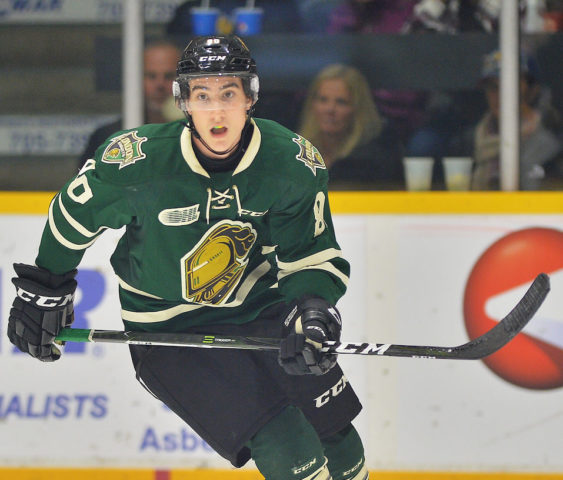
The other defenders in tier two are Bernard-Docker and newly drafted Thomson. Drafted 26th overall in the 2018 NHL Entry Draft, Bernard-Docker had a solid freshman campaign at the University of North Dakota. He’s one of the team’s best players, and that was proven by his invite to this past year’s Team Canada tryouts. At just 18, there’s a lot of potential for this defender moving forward. He’s at least a couple of years away, but Bernard-Docker could one day end up being Chabot’s partner on the top pairing.
Thomson was the Senators first selection in the 2019 NHL Draft, selected 21st overall. A right-handed defender, Thomson finished up the 2018-19 season in the WHL as a finalist for Rookie of the Year and was named to a WHL Western Conference Second Team All-Star. In 63 games, he had 17 goals and 24 assists for 41 points. He could very easily be the Senators second-best defensive prospect.
Related: Senators Fill Need by Drafting Thomson
Finally, there are the goaltenders Gustavsson and Søgaard. Gustavsson seemed to struggle at times in 2018-19 in Belleville. Despite this season, he still has the potential to be the Senators’ next number one goaltender. The 20-year-old already has a World Championship gold medal and a World Junior Championship silver medal, where he won the best goaltender and was named to the All-Star team.
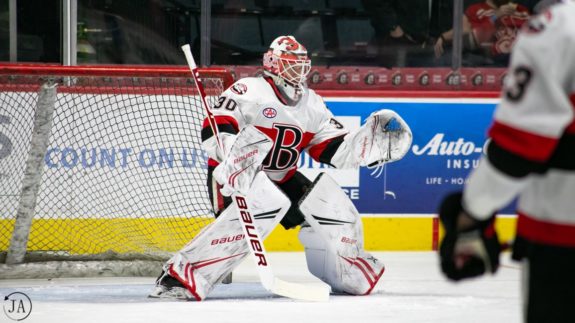
Søgaard is the new goaltender on the block and early on it looks like he could have the highest ceiling out of all of the netminders. While Gustavsson looked to be the number one goaltender of the future prior to last season, there are a number of candidates now, with Søgaard right there. The Senators traded up for the 6-foot-7 netminder who has great movement, patience and puck handling. He’s a highly skilled goalie who brings a ton of potential to the organization’s future.
Tier 3: Abramov, Chlapik, Daccord, Davidsson, Hogberg & Pinto
Some players in this tier may even be able to jump to tier two, but we just haven’t seen enough to prove it yet, despite stellar performances this past season. The tier three players are Vitali Abramov, Filip Chlapik, Joey Daccord, Jonathan Davidsson, Marcus Hogberg, and Shane Pinto. Similar to tier two, a couple of players on this list could even start the season in the NHL.
Abramov and Davidsson came from the Columbus Blue Jackets together in the Matt Duchene trade. Abramov had a huge career in the QMJHL, collecting 223 points in 145 games. We know the offence is there, now to see if he can bring it at higher levels. It wouldn’t be surprising to see him get some NHL time this season.
Davidsson came over in the deal not as well-known as Abramov but looks like he could be the better prospect. He’s played well in the SHL against men and we’ll get a better look at him this season in Belleville. He’s one of the Senators’ prospects I’m most interested in keeping an eye on this season.
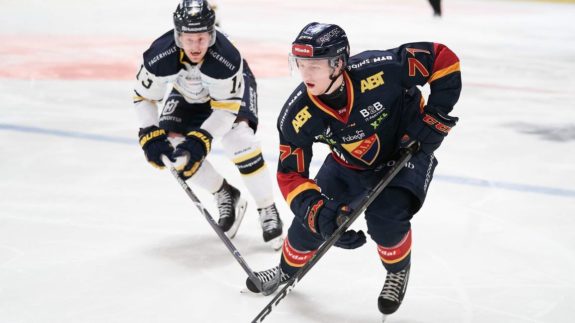
Chlapik led Belleville in 2017-18 in points, with 32 in 52 games. Over the last couple seasons, the 48th overall pick from 2015 has seemed to have been leaped by other prospects, like Tkachuk, Colin White, Formenton and Batherson, but he does still have the potential for the top-nine, possibly higher if he continues to progress. It’s likely that he gets some NHL time so management can see where he’s at in his development. The 2019-20 season could be make-or-break for Chlapik.
A draft selection that shocked many, Pinto looks to be a great two-way prospect with a great shot and the ability to make plays. As Senators fans watch the young prospect play, I expect them to warm up to him quickly. He may not jump off the scoreboard or make dazzling plays, but he’ll be a consistent player at both ends which is what the team needs moving forward.
Goaltender Daccord shocked many hockey fans last season. The 199th pick in 2015 went from seventh-round draft pick to elite NCAA goaltender, even making his NHL debut. He has lots of potential if he continues to take steps forward, for now, he’ll likely play with the ECHL’s Brampton Beast for the 2019-20 season to see what he can do there.
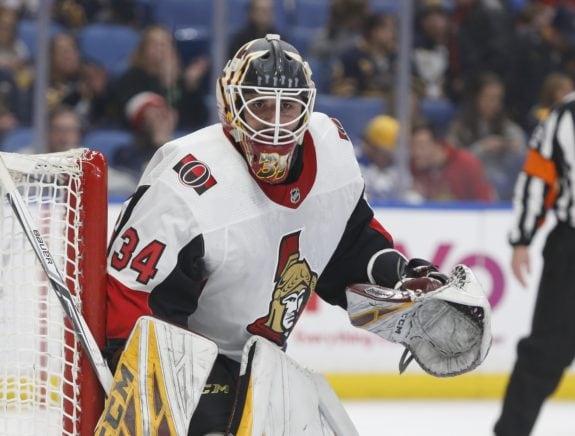
Finally, Hogberg is the fourth goaltender on this list and the second one in tier three. Hogberg was a machine with Belleville in 2018-19, going 21-11-6 and nearly helping the team to the playoffs. They just fell short, but Hogberg gave them a chance. He could see some NHL time this season in Anders Nilsson or Craig Anderson gets hurt.
Tier 4: Carcone, Crookshank, Gruden, Kelly, Rodewald, Tychonick & Veronneau
The Senators currently have six players who could make the NHL roster but in more of a role-player position. These players include Michael Carcone, Angus Crookshank, Jonathan Gruden, Parker Kelly, Jack Rodewald, Jonny Tychonick and Max Veronneau.
Carcone came over from the Toronto Maple Leafs in the Cody Ceci and Nikita Zaitsev deal, after being acquired by the Maple Leafs just seven months earlier. His ceiling isn’t very high, but he could fit into the bottom-six moving forward. With the team likely to sell off more assets this season, it’s likely he could see some NHL time this season.
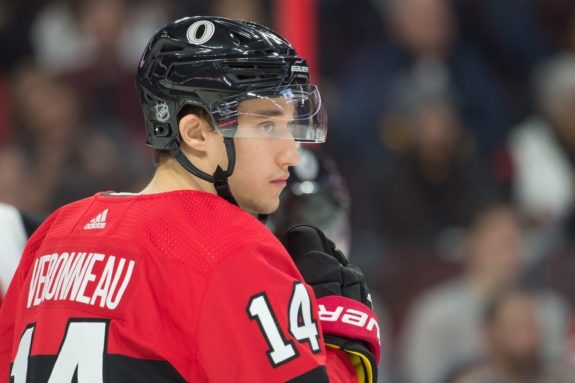
Gruden and Crookshank were both drafted in 2018, 95th and 126th overall, respectfully. Gruden was coming off of an impressive 60-point performance with the U.S. National U18 team in 61 games. Crookshank, on the other hand, is on the rise and may jump into the third tier. Playing with the University of New Hampshire, the left-winger exceeded expectations, impressing with his play. He was climbing the Senators prospects lists all season and doesn’t look like he’s done.
Kelly is coming off of a WHL Championship run with the Prince Albert Raiders. He had a great year with 35 goals and 67 points in 64 games, adding 17 points in 23 games. In the original pyramid, I had Kelly in the fifth tier. He’s one of the only prospects I had to move up in this edition. He’s one to watch for the 2019-20 season.
Rodewald just had the best season of his career, but his ceiling still remains relatively low. He could fit into the bottom-six moving forward, possibly the middle-six. He battles hard though, so it wouldn’t surprise me to see him become a regular NHL depth forward.
The Senators’ Tychonick and Bernard-Docker picks were actually both received by the Senators in the same trade, with the New York Rangers in exchange for the 22nd-overall pick (K’Andre Miller). They both played for the University of North Dakota as freshmen. Tychonick hasn’t caught on to the speed of college hockey like Bernard-Docker has, but there is still potential for the young defender.
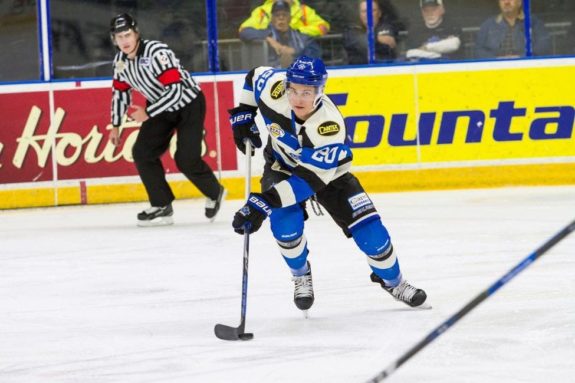
Veronneau is the Senators latest college free agent signing. He put up 144 points in 130 games with the Princeton University Tigers and was a finalist for the Hobey Baker Award in consecutive seasons. He played 12 games in the NHL after being signed and didn’t look out of place. While his ceiling is likely a middle-six winger, he could be a solid piece of the organization’s future.
Related: Senators Hope Veronneau Breaks College UFA Trend
Tier 5: Alsing, Englund, Lodin, Loheit, Mandolese, Nurmi & Sturtz
Olli Alsing, Andreas Englund, Viktor Lodin, Luke Loheit, Kevin Mandolese, Markus Nurmi and Andrew Sturtz fill out the fifth tier, all players who could make the NHL, but at this point, it looks like a long-shot for them to become regulars with the Senators.
Alsing is one of the new signees for the Senators, coming over from the SHL last season. However, at 23-years-old, it looks like he isn’t going to raise his ceiling too much. With the Senators young, defensive depth, it’s likely that he’ll be an AHL defender and possibly see an occasional call-up.
Englund is in a similar boat. drafted back in 2014, 40th overall, the defender hasn’t really lived up to that selection. At this point, it looks like he could be a solid AHL defender with an occasional call-up.
Newly-drafted Lodin will be an interesting player to follow. He saw some time in the SHL, after a very good SuperElit performance. He’s a few years away from really knowing how he’ll perform, but I wouldn’t be surprised to see him rise up these tiers. There’s potential down the line here. Loheit is in a similar situation, a player who has shown flashes of being a good prospect, but at the same time, his ceiling looks fairly low.
The lone goaltender in this tier, Mandolese was the second-ranked goalie by NHL Central Scouting in the 2018 NHL Entry Draft. However, he hasn’t really taken big steps forward since being selected. With the team’s depth in net, it’s likely the unsigned netminder will either be moved or let walk when his signing rights are up.
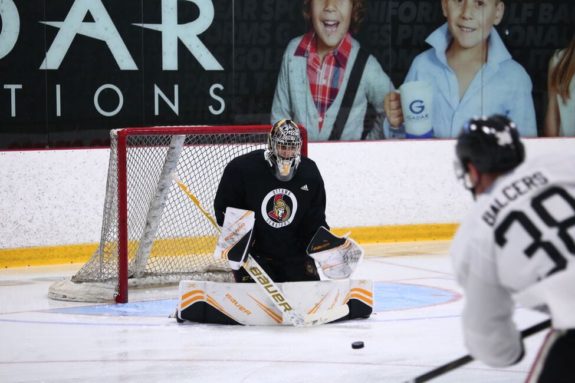
Nurmi might not be on this list for long, and it’s not because of graduating. Drafted in 2016, he remains unsigned and he hasn’t taken many steps forward despite playing in the Finnish Liiga. This past season he saw his goal totals drop from 10 goals to 1 in 60 games. His ceiling is probably the AHL at this point.
Finally, Sturtz is likely right where he’ll remain, in the AHL. He showed some incredible offensive ability in the CCHL and even the NCAA, but it hasn’t really translated to the AHL. Of course, there’s a chance he could surprise, but at 24, he’s already pretty close to his ceiling.
Tier 6: Everyone Else
The sixth tier is for those who either really won’t have a shot at the NHL, or there isn’t enough information to make an informed decision.
This includes JC Beaudin, Todd Burgess, Nick Ebert, Miles Gendron, Maxence Guénette, Mark Kastelic, Morgan Klimchuk, Jakov Novak, Mikael Wilkstrand. There’s still a chance that some of these players could one day crack the NHL roster, but at this point, it’s not looking very likely. Their ceiling as of now would be the AHL.
The Prospect Pyramid is Constantly Changing
As prospects continue their career, they can rise and fall through the tiers on this list. Daccord is a prime example of this, as he may have been a fourth- or fifth-tier prospect at the beginning of the 2018-19 season but has risen to the third tier. That could change again before he truly gets a crack at the NHL. The point is, these groupings are not a fixed evaluation of these prospects, but a fluid guide that is constantly changing as moves are made in the organization, drafts occur and the general progression or regression of their play.